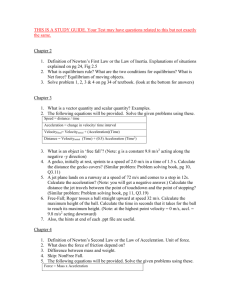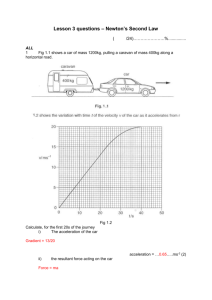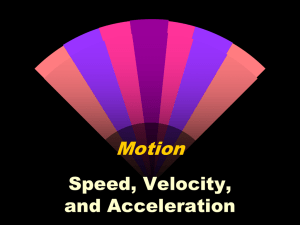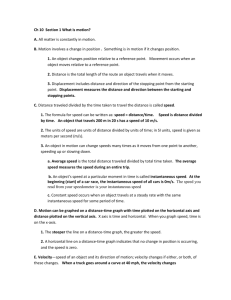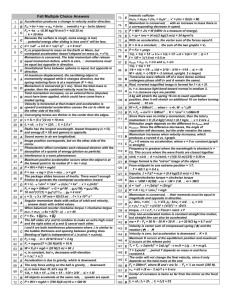Physical Science Mid-Term Exam Review - High School
advertisement
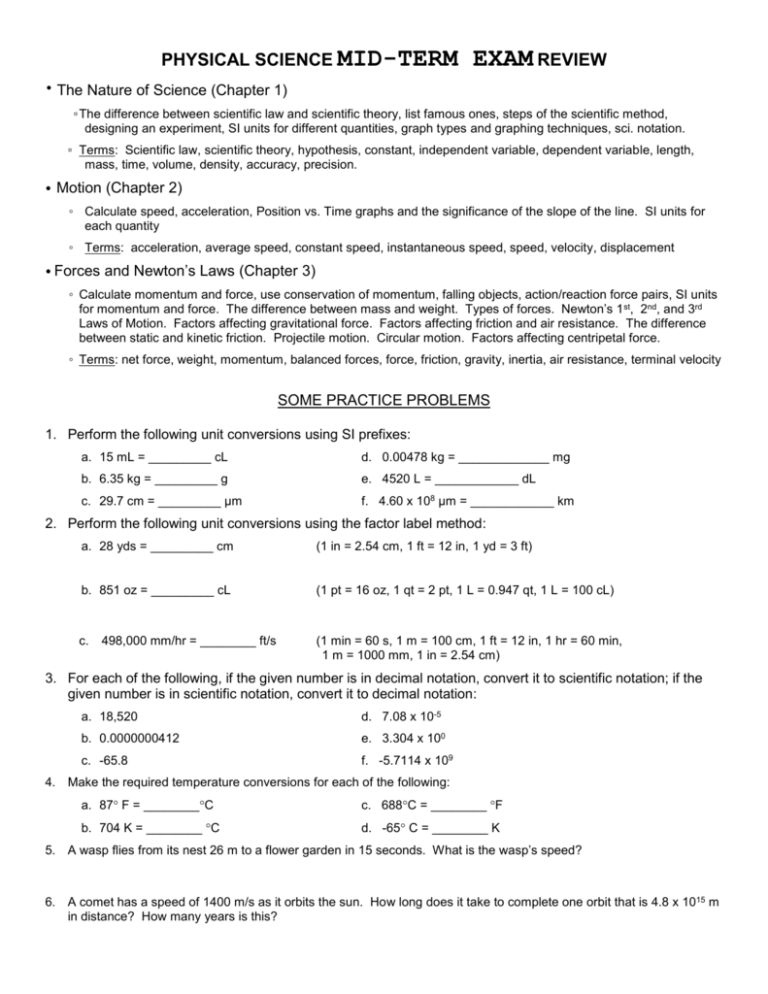
PHYSICAL SCIENCE MID-TERM EXAM REVIEW • The Nature of Science (Chapter 1) ▫ The difference between scientific law and scientific theory, list famous ones, steps of the scientific method, designing an experiment, SI units for different quantities, graph types and graphing techniques, sci. notation. ▫ Terms: Scientific law, scientific theory, hypothesis, constant, independent variable, dependent variable, length, mass, time, volume, density, accuracy, precision. • Motion (Chapter 2) ◦ Calculate speed, acceleration, Position vs. Time graphs and the significance of the slope of the line. SI units for each quantity ◦ Terms: acceleration, average speed, constant speed, instantaneous speed, speed, velocity, displacement • Forces and Newton’s Laws (Chapter 3) ◦ Calculate momentum and force, use conservation of momentum, falling objects, action/reaction force pairs, SI units for momentum and force. The difference between mass and weight. Types of forces. Newton’s 1 st, 2nd, and 3rd Laws of Motion. Factors affecting gravitational force. Factors affecting friction and air resistance. The difference between static and kinetic friction. Projectile motion. Circular motion. Factors affecting centripetal force. ◦ Terms: net force, weight, momentum, balanced forces, force, friction, gravity, inertia, air resistance, terminal velocity SOME PRACTICE PROBLEMS 1. Perform the following unit conversions using SI prefixes: a. 15 mL = _________ cL d. 0.00478 kg = _____________ mg b. 6.35 kg = _________ g e. 4520 L = ____________ dL c. 29.7 cm = _________ µm f. 4.60 x 108 µm = ____________ km 2. Perform the following unit conversions using the factor label method: a. 28 yds = _________ cm (1 in = 2.54 cm, 1 ft = 12 in, 1 yd = 3 ft) b. 851 oz = _________ cL (1 pt = 16 oz, 1 qt = 2 pt, 1 L = 0.947 qt, 1 L = 100 cL) c. (1 min = 60 s, 1 m = 100 cm, 1 ft = 12 in, 1 hr = 60 min, 1 m = 1000 mm, 1 in = 2.54 cm) 498,000 mm/hr = ________ ft/s 3. For each of the following, if the given number is in decimal notation, convert it to scientific notation; if the given number is in scientific notation, convert it to decimal notation: a. 18,520 d. 7.08 x 10-5 b. 0.0000000412 e. 3.304 x 100 c. -65.8 f. -5.7114 x 109 4. Make the required temperature conversions for each of the following: a. 87 F = ________C c. 688C = ________ F b. 704 K = ________ C d. -65 C = ________ K 5. A wasp flies from its nest 26 m to a flower garden in 15 seconds. What is the wasp’s speed? 6. A comet has a speed of 1400 m/s as it orbits the sun. How long does it take to complete one orbit that is 4.8 x 1015 m in distance? How many years is this? 7. A slug slithers for one hour at a speed of 5 cm/s. How far in meters does it travel in this time? 8. A delivery truck starts from rest at a stop sign and increases its velocity to 14 m/s, north in 7.5 s. Find its acceleration. 9. A train slows down as it nears a town from 24 m/s, east to 8 m/s, east over a 3-minute period. Find its acceleration. 10. On page 69 of your textbook is a graph of distance vs. time. Use the graph to answer #11 and 12 from the book. 11. The Steelers offensive linemen and the Steelers water boys are having a tug of war, using a 10 kg bar instead of a rope. The Steelers pull with 10000 N of force to the right while the water boys pull with 8000 N of force to the left. What is the net force on the bar? What will its acceleration be? 12. Cletus and his brother Punkinhead have just come home from a day of possum huntin’. They know that the possums’ mass is 16 kg, but their Ma needs to know how much the possums weigh so she can use the right amount of ingredients in tonight’s possum stew. How much do the possums weigh? 13. Ma’s recipe for possum stew calls for 15 N of craw daddies. What is the mass of the craw daddies? 14. A 55 kg figure skater moves with a velocity of 4.5 m/s, north. What is her momentum? 15. A 75 kg figure skater has the same momentum as the skater in #14. What is his velocity? 16. A bullet’s velocity is 380 m/s, to the left. If its momentum is 12 kg m/s, what is the mass of the bullet in grams? 17. A water rocket blasts off from the ground, starting from rest. 300 grams of water shoot downward at 38 m/s. What is the speed of the 120 g empty rocket? ANSWERS: 1. a) 1.5, b) 6350, c) 297,000, d) 4780, e) 45,200, f) 0.460; 2. a) 2560 cm, b) 2808 cL, c) 0.454 ft/s; 4. a) 30.6, b) 431, c) 1270.4, d) 208; 5. 1.73 m/s; 6. 3.43 × 1012 s or 109,000 yrs; 7. 180 m; 8. 1.87 m/s²; 9. -0.089 m/s²; 11. Fnet = 2000 N right, a = 200 m/s², right; 12. 157 N; 13. 1.53 kg; 14. 247.5 kg m/s, north; 15. 3.3 m/s, north; 16. 31.6 g; 17. 95 m/s, up,





